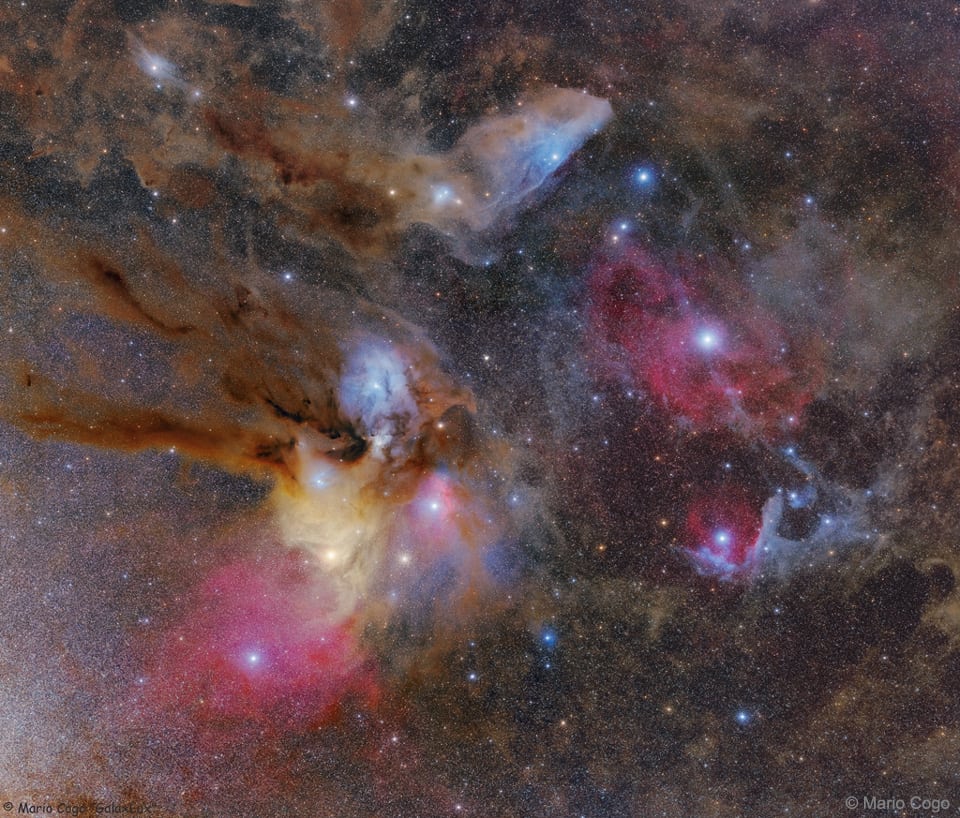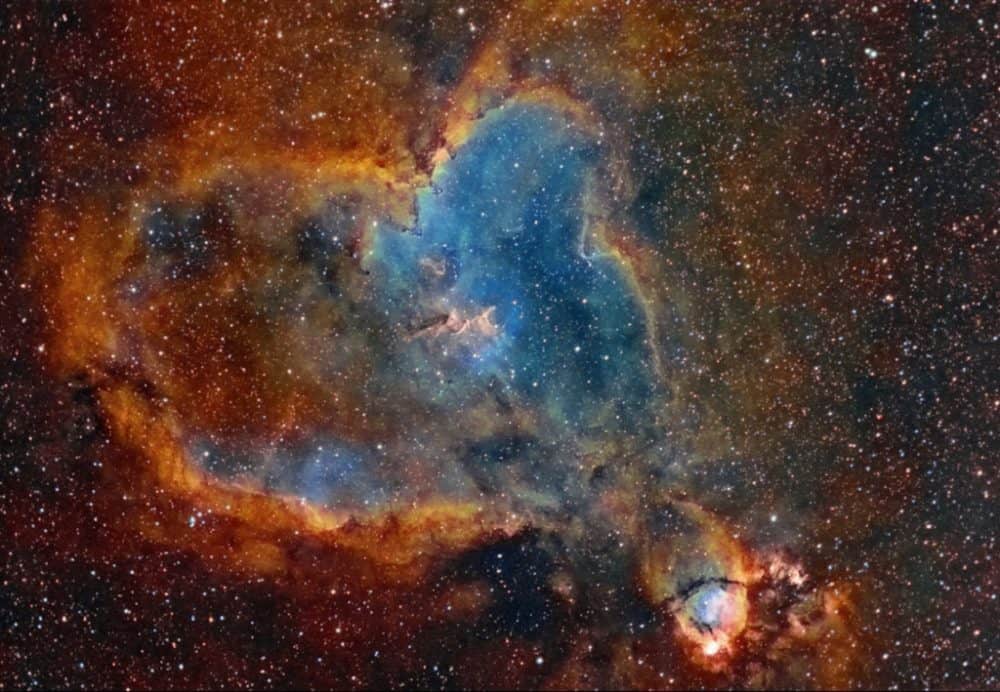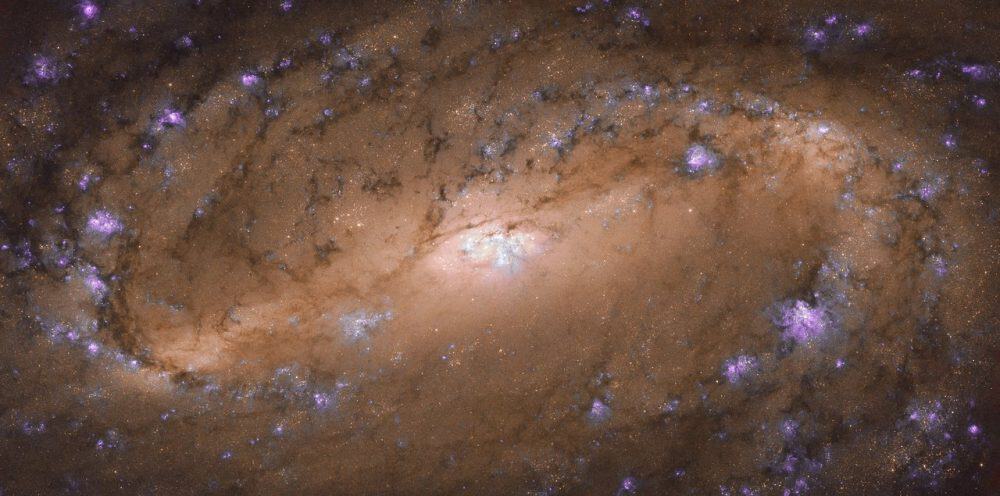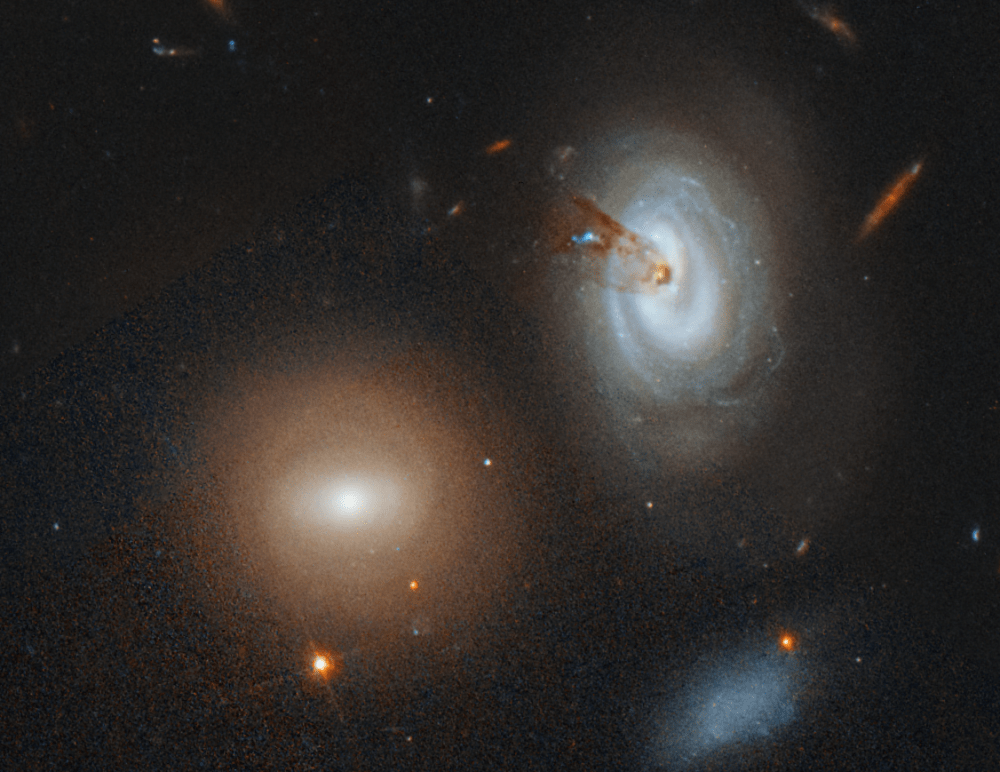Blog
The colorful clouds surrounding the star system Rho Ophiuchi compose one of the closest star forming regions. Rho Ophiuchi itself is a binary star system visible in the blue reflection nebula just to the left of the image center. The star system, located only 400 light years away, is distinguished by its multi-colored surroundings, which include a red emission nebula and numerous light and dark brown dust lanes. Near the lower left of the Rho Ophiuchi molecular cloud system is the yellow star Antares, while a distant but coincidently-superposed globular cluster of stars, M4, is visible just to the right of Antares. Near the image top lies IC 4592, the Blue Horsehead nebula. The blue glow that surrounds the Blue Horsehead’s eye — and other stars around the image — is a reflection nebula composed of fine dust. On the featured image right is a geometrically angled reflection nebula cataloged as Sharpless 1. Here, the bright star near the dust vortex creates the light of surrounding reflection nebula. Although most of these features are visible through a small telescope pointed toward the constellations of Ophiuchus, Scorpius, and Sagittarius, the only way to see the intricate details of the dust swirls, as featured above, is to use a long exposure camera.
more...Stevland Hardaway Morris (né Judkins; born May 13, 1950), better known by his stage name Stevie Wonder, is an American singer, songwriter, musician, record producer, and multi-instrumentalist.
A child prodigy, Wonder is considered to be one of the most critically and commercially successful musical performers of the late 20th century. He signed with Motown‘s Tamla label at the age of 11, and continued performing and recording for Motown into the 2010s. He has been blind since shortly after his birth. Among Wonder’s works are singles such as “Signed, Sealed, Delivered I’m Yours“, “Superstition“, “Sir Duke“, “You Are the Sunshine of My Life“, and “I Just Called to Say I Love You“; and albums such as Talking Book (1972), Innervisions(1973), and Songs in the Key of Life (1976). He has recorded more than 30 U.S. top-ten hits and received 25 Grammy Awards, one of the most-awarded male solo artists, and has sold more than 100 million records worldwide, making him one of the top 60 best-selling music artists.
Wonder is also noted for his work as an activist for political causes, including his 1980 campaign to make Martin Luther King Jr.‘s birthday a holiday in the United States. In 2009, Wonder was named a United Nations Messenger of Peace. In 2013, Billboard magazine released a list of the Billboard Hot 100 All-Time Top Artists to celebrate the US singles chart’s 55th anniversary, with Wonder at number six.
more...William McKinley “Red” Garland, Jr. (May 13, 1923 – April 23, 1984) was an American modern jazz pianist. Known for his work as a bandleader and during the 1950s with Miles Davis, Garland helped popularize the block chord style of piano playing. William “Red” Garland was born in 1923 in Dallas, Texas. He began his musical studies on the clarinet and alto saxophone but, in 1941, switched to the piano. Less than five years later, Garland joined the trumpet player Hot Lips Page, well-known in the southwest, playing with him until a tour ended in New York in March 1946. Having decided to stay in New York to find work, Art Blakey came across Garland playing at a small club, only to return the next night with Blakey’s boss, Billy Eckstine.
Garland also had a short-lived career as a welterweight boxer in the 1940s. He fought more than 35 fights, one being an exhibition bout with Sugar Ray Robinson. Garland became famous in 1954 when he joined the Miles Davis Quintet, featuring John Coltrane, Philly Joe Jones, and Paul Chambers. Davis was a fan of boxing and was impressed that Garland had boxed earlier in his life. Together, the group recorded their famous Prestige albums, Miles: The New Miles Davis Quintet (1954), Workin, Steamin’, Cookin’, and Relaxin’. Garland’s style is prominent in these seminal recordings—evident in his distinctive chord voicings, his sophisticated accompaniment, and his musical references to Ahmad Jamal’s style. Some observers dismissed Garland as a “cocktail” pianist, but Miles was pleased with his style, having urged Garland to absorb some of Jamal’s lightness of touch and harmonics within his own approach.
more...Ian Ernest Gilmore Evans (born Green; May 13, 1912 – March 20, 1988) was a Canadian jazz pianist, arranger, composer and bandleader. He is widely recognized as one of the greatest orchestrators in jazz, playing an important role in the development of cool jazz, modal jazz, free jazz, and jazz fusion. He is best known for his acclaimed collaborations with Miles Davis.
https://www.youtube.com/watch?v=xAVzB2ifVZo
more...The Heart Nebula, IC 1805, Sharpless 2-190, lies some 7500 light years away from Earth and is located in the Perseus Arm of the Galaxy in the constellation Cassiopeia. It was discovered by William Herschel on 3 November 1787. This is an emission nebula showing glowing ionized hydrogen gas and darker dust lanes.
The very brightest part of this nebula (the knot at the western edge) is separately classified as NGC 896, because it was the first part of this nebula to be discovered.
The nebula’s intense red output and its configuration are driven by the radiation emanating from a small group of stars near the nebula’s center. This open cluster of stars known as Melotte 15 contains a few bright stars nearly 50 times the mass of our Sun, and many more dim stars that are only a fraction of our Sun’s mass.
more...Stephen Lawrence Winwood (born 12 May 1948) is an English singer and musician whose genres include progressive rock, blue-eyed soul, rhythm and blues, blues rock, pop rock, and jazz. Though primarily a vocalist and keyboardist, Winwood also plays a wide variety of other instruments; on several of his solo albums he recorded all instrumentation including drums, guitars, and keyboards.
Winwood was a key member of The Spencer Davis Group, Traffic, Blind Faith and Go. He also had a successful solo career with hits including “While You See a Chance“, “Valerie“, “Back in the High Life Again” and two US Billboard Hot 100 number ones, “Higher Love” and “Roll with It“. He was inducted into the Rock and Roll Hall of Fame as a member of Traffic in 2004.
In 2005, Winwood was honoured as a BMI Icon at the annual BMI London Awards for his “enduring influence on generations of music makers”. In 2008, Rolling Stone ranked Winwood No. 33 in its 100 Greatest Singers of All Time. Winwood has won two Grammy Awards. He was nominated twice for a Brit Award for Best British Male Artist: 1988 and 1989. In 2011 he received the Ivor Novello Award from the British Academy of Songwriters, Composers and Authors for Outstanding Song Collection.
more...Gary Peacock (born May 12, 1935, in Burley, Idaho, United States) is an American jazz double-bassist.
Peacock spent time in Japan in the late 1960s, abandoning music temporarily and studying Zen philosophy. After returning to the United States in 1972, he studied Biology at the University of Washington in Seattle and taught music theory at Cornish College of the Arts from 1976 to 1983.
In 1983, he joined Keith Jarrett‘s “Standards Trio” with Jack DeJohnette (the three musicians had previously recorded Tales of Another in 1977 for ECM Records, under Peacock’s leadership). Among the trio’s albums are Standards, Vol. 1 and Standards, Vol. 2 and Standards Live.
more...NGC 2903 is located about 30 million light-years away in the constellation of Leo (The Lion), and was studied as part of a Hubble survey of the central regions of roughly 145 nearby disc galaxies. This study aimed to help astronomers better understand the relationship between the black holes that lurk at the cores of galaxies like these, and the rugby-ball-shaped bulge of stars, gas, and dust at the galaxy’s centre — such as that seen in this image.
NGC 2903 is a field barred spiral galaxy about 30 million light-years away in the constellation Leo. It was discovered by William Herschel who cataloged it on November 16, 1784. NGC 2903 has a very high rate of star formation in its central region. NGC 2905 is a bright star cloud within this galaxy. NGC 2903 is part of the Virgo Supercluster.
more...Eric Victor Burdon (born 11 May 1941) is an English singer-songwriter and actor. He was previously the vocalist of rock band The Animals and funk band War. He is regarded as one of the British Invasion‘s most distinctive singers with his deep, powerful blues-rock voice. He is also known for his aggressive stage performances.
In 2008, he was ranked 57th in Rolling Stone‘s list The 100 Greatest Singers of All Time. Burdon was lead singer of the Animals, formed during 1962 in Newcastle upon Tyne. The original band was the Alan Price Rhythm and Blues Combo, which formed in 1958;[10] they became the Animals shortly after Burdon joined the band. The Animals combined electric blues with rock and in the USA were one of the leading bands of the British Invasion.[11] Along with the Beatles, the Rolling Stones, the Who, the Hollies, the Dave Clark Five, and the Kinks, the group introduced British music and fashion. Burdon’s powerful voice can be heard on the Animals’ singles “The House of the Rising Sun“, “Baby Let Me Take You Home“, “I’m Crying“, “Boom Boom“, “Don’t Let Me Be Misunderstood“, “Bring It On Home to Me“, “We Gotta Get out of This Place“, “It’s My Life“, “Don’t Bring Me Down“, “See See Rider“, “Monterey“, and “Sky Pilot“.
more...
Carla Bley (born Lovella May Borg, May 11, 1936) is an American jazz composer, pianist, organist and bandleader. An important figure in the free jazz movement of the 1960s, she is perhaps best known for her jazz opera Escalator over the Hill (released as a triple LP set), as well as a book of compositions that have been performed by many other artists, including Gary Burton, Jimmy Giuffre, George Russell, Art Farmer, John Scofield and her ex-husband Paul Bley.
Bley was born in Oakland, California to Emil Borg (1899–1990), a piano teacher and church choirmaster, who encouraged her to sing and to learn to play the piano, and Arline Anderson (1907–1944), who died when Bley was eight years old. After giving up the church to immerse herself in roller skating at the age of fourteen, she moved to New York at seventeen and became a cigarette girl at Birdland, where she met jazz pianist Paul Bley.
more...Born 5-11-1916 Died march 21 2016
After serving in the U.S. Air Force, he became a musician. He was a studio musician and played with many famous artists such as Connie Smith, Pee Wee King and the Osborne Brothers. He also produced many of his own recordings. He won the Champion of Champions Thumb Picking Contest in Central City Kentucky and was inducted into the Kentucky Music Hall of Fame, and performed regularly at The Ozark Folk Center in Mountain View, Ark. with Sassafras Moon.
He is survived by his wife, Theda Mullins of Vicksburg; son, Mark Mullins of North Carolina; five brothers; five sisters; and one grandchild. In 1985, he won the National Merle Travis Tribute thumbpicking contest at the Ozark Folk Center in Arkansas.
He captured top honors in 1991 at the International Thumbpicking Contest in Central City, Ky.
Then, in a special 1996 contest allowing only the former international champions to compete, Mullins won first place as the “Champion of Champions.”
On a recent morning, Mullins scoots a kitchen chair into the living room and grabs his favorite guitar, made by master builder Dumitru Manea of Nashville, Tenn.
“I won this in a contest, by the way, and it’s an incredible instrument,” Mullins says.
He soon inserts his right thumb into a pick and launches into “Hello, My Baby,” which has a simple ragtime quality to it.
His thumb beats out the bass rhythm, and those fingers with the fake nails seem to make a sound of several instruments in harmony.
more...
Bakino Faso
more...https://www.youtube.com/watch?v=R0mUnt1kPhs
more...The spiral galaxy D100, on the far right of this Hubble Space Telescope image, is being stripped of its gas as it plunges toward the center of the giant Coma galaxy cluster.
The dark brown streaks near D100’s central region are silhouettes of dust escaping from the galaxy. The dust is part of a long, thin tail, also composed of hydrogen gas, that stretches like taffy from the galaxy’s core. Hubble, however, sees only the dust. The telescope’s sharp vision also uncovered the blue glow of clumps of young stars in the tail. The brightest clump in the middle of the tail (the blue feature) contains at least 200,000 stars, fueled by the ongoing loss of hydrogen gas from D100.
The gas-loss process occurs when D100, due to the pull of gravity, begins falling toward the dense center of the massive Coma cluster, consisting of thousands of galaxies. During its plunge, D100 plows through intergalactic material like a boat plowing through water. This material pushes gas and dust out of the galaxy. Once D100 loses all of its hydrogen gas, its star-making fuel, it can no longer create new stars. The gas-stripping process in the beleaguered galaxy began roughly 300 million years ago.
The reddish galaxies in the image contain older stars between the ages of 500 million to 13 billion years old. One of those galaxies is D99, just below and to the left of D100. It was stripped of its gas by the same process as the one that is siphoning gas from D100. The blue galaxies contain a mixture of young and old stars. Some of the stars are less than 500 million years old. The Coma cluster is located 330 million light-years from Earth.
more...More Posts
- World Music African Classical Music Ensemble
- Daily Roots the Gladiators
- What happened to the brilliant minds and heartfelt leaders?
- Cosmos Sh2-155
- Jim Croce
- Mike Stern
- Max Roach
- World Music KITKA
- Daily Roots Jackie Brown
- Cosmos NGC 2359
- Jimi Page
- Joan Báez
- Kenny Clarke
- Bucky Pizzarelli
- World Fusion Ablaye Cissoko & Cyrille Brotto
- Daily Roots Junior Marvin
- Cosmos Arp 122
- Shirley Bassey
- David Bowie
- Elvis Presley






